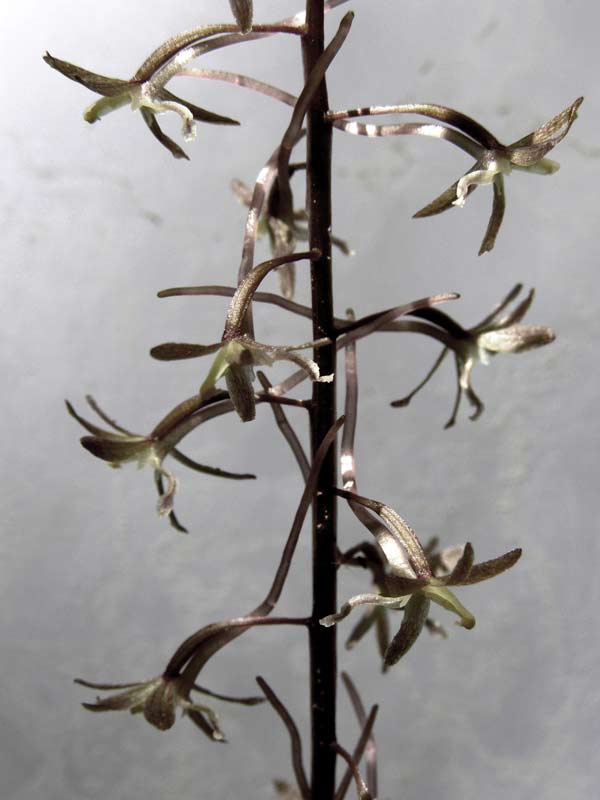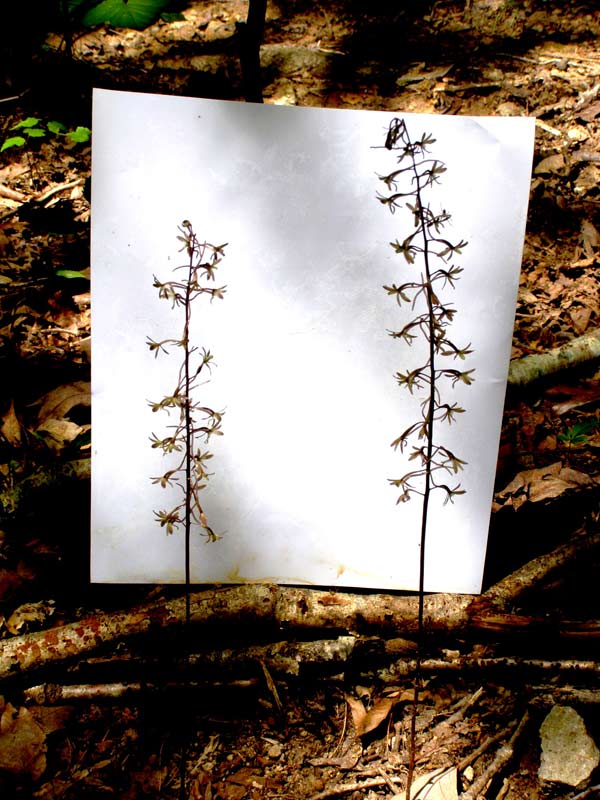Opening soon in a woods near you

A hand lens or magnifying glass is helpful for viewing the Crane-fly Orchid flower. Photo by Ken Moore
By Ken Moore Flora Columnist
They’re late this year. The specimens in my parched woodland have not yet shown themselves. Over in the middle of Carrboro – more showers over there – they’re up but not in flower, and along the trails of the Botanical Garden – lots more showers over there – they’re in full flower!
Well now, unlike most wildflowers these are not going to knock your socks off with a showy display of color. You can easily complete your woodland stroll without ever seeing this diminutive native orchid down by your footsteps. Sadly, a number of them, growing too close to the edge of the path, sometimes in the path, will be trampled by innocent feet.
Those unfortunate ones will not have opportunity for pollination and production of the talcum powder-like seed this season.
Even the experienced wildflower enthusiast is challenged to find the Crane-fly Orchid, Tipularia discolor. I am always surprised whenever I spy my first one of the summer.
Usually I am aided by a serendipitous beam of sunlight streaming through the tree canopy, momentarily spotlighting that stalk of greenish-brown – or is that brownish-green? – little orchid flowers. The flower color is hard to discern and there are no leaves. The flowering stalk is a wire-like stem from 8†to 18†tall. So it’s really easy to miss.
But once you do see it, and now you’re down on hands and knees for a closer look, you’ll most likely spy several more close by. They generally occur in small colonies and often those colonies are lined up as if in an orderly march. If you observe the forest floor carefully, you may detect the remains of a long-ago-fallen tree that has ever so slowly decomposed to provide a favorable nursery bed appropriate for the very particular growth requirements of this terrestrial orchid. As you pull yourself up from the ground and continue your woodland stroll, you will surprise yourself at how readily you may find more of these Crane-fly Orchids.

Without a contrasting background, Crane-fly Orchids are almost invisible on the forest floor. Photo by Ken Moore.
These obscure, but abundant, orchids are more easily located during winter walks. The single, egg-shaped leaf, dark green above and burgundy colored beneath, emerges in the early fall to take advantage of the winter sunlight reaching the forest floor through the bare branches of the forest canopy. One would be inclined to describe it as evergreen, but it goes dormant in the spring of the year, a sort of reversal of the dormancy of most deciduous plants.
Good luck in your search. Take a hand lens or magnifying glass with you for a closer look.
Your imagination may even allow you to see some similarity to the crane-fly insect with which its name is associated. Most likely, you’ll be happy to have seen this wildflower; if not, just think – now you have a perfectly logical explanation if some day you are caught lying down along some woodland pathway.
Email Ken Moore at flora@carrborocitizen.com.
Find more Ken Moore Citizen columns at The Annotated Flora


Comments are closed.